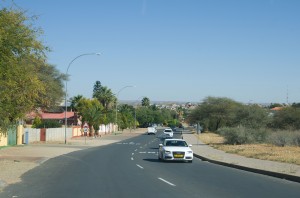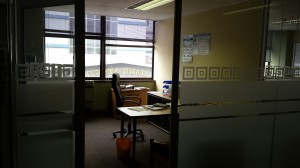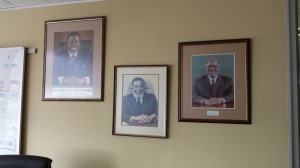 By Zachary Shefman
By Zachary Shefman
Gaba, on my morning drive to work, carefully navigates around the men and women that file past as they climb the sloped, well-paved streets of the neighbourhood in which I live. Many of them wear dark blue jump suits to signal both that they are labourers, and that they are currently on the job. Since there are relatively few sidewalks in Windhoek, they are forced to climb the streets on the shoulders of the road.

As we progress along Robert Mugabe Avenue towards the centre of the city, I am surprised at the number of luxury cars that accompany us on our route – Mercedes-Benz, Audi, and Porsche, among others. I ask my co-worker sitting next to me what the green license plates, in contrast with the more typical yellow, on many of the luxury cars represent. “Government,” he says, “this way they cannot use these cars how they please”.
We approach the Parliament buildings to drop off one of our passengers. However, unlike most days, we are prohibited from entering the premises. The roads are blocked with police vehicles, and men and women in uniform are posted around the garden entrance every ten to fifteen feet.
Today, June 16th, is a special day for a number of reasons. For one, the Indian President is on a state visit to Namibia and is slated to address the Namibian National Assembly. Security is accordingly tight. For another, it is the Day of the African Child. This day marks the student uprising of 1974 in Soweto, South Africa, where students marched to oppose the establishment of Afrikaans as the language of instruction.[1] Most importantly of all, however, it is the day chosen by the Affirmative Repositioning movement (AR) to protest the government’s ostensible commitment of NAM$ 2.2 billion to the construction of new Parliament buildings.[2]
The AR is an organization whose principal aim is to lobby for the redistribution of land to Namibian youth.[3] They have called for a day of action to demand that the government reallocate the resources allegedly earmarked for Parliament to the distribution of 25 000 plots to the landless instead.[4] They plan to deliver a petition to the Speaker of the National Assembly, Peter Kajavivi, with their demands.[5]
The AR, however, has encountered a number of obstacles to their plans for a demonstration. A week ago, the Inspector-General of the Namibian Police Force, Sebastien Ndeitunga, placed a ban on all public demonstrations from June 13th to 18th.[6] Four days ago, the Ministry of Education, Arts and Culture issued an unusual directive to schools across the country requiring that they organize activities for the Day of the African child, rather than allow teachers and students the typical June 16th off.[7]
When I arrive at the office, I can hear the distant hum of shouts and horns of a demonstration. The defiant AR has continued with their march. I worry that the protest will degenerate into violence.
“Come hell or high water we will march” – Dimbulukeni Nauyoma, an activist of the Affirmative Repositioning movement.[8]
It is June 17th, and I anxiously fumble through the newspapers strewn across my colleague’s desk. Despite my concerns, the protest was ultimately both successful and peaceful.[9] The Namibia National Teacher’s Union and the Namibian National Students’ Organization, for instance, defied the Ministry’s order to hold and attend commemorative activities on June 16th.[10] Ndeintunga, the Inspector-General, ultimately came to an agreement with the AR. They decided to redirect the route so that the march ended at Synman Circle, rather than the Parliament buildings, provided that the Speaker of the National Assembly received their petition.[11] Finally, despite the Speaker’s initial refusal to greet the protestors in order to accept the petition, he eventually relented.[12]

This year marks the 26th anniversary of Namibia’s independence, and the period in which the first post-apartheid generation has finally come of age. These are the men and women “born free” – i.e. born under a democratic government, rather than the oppressive rule of the former South African occupiers.
Living conditions between pre and post-independence Namibia have changed considerably. The country has made significant progress reducing poverty, for instance, though the number of indigent Namibians is still relatively high. According to the Namibian Statistics Agency, while 69.3% of Namibians lived below the poverty line in 1993/4, by 2009/10, that number was reduced to 28.7%.[13]
For many Namibians, however, the pace of change has not progressed fast enough. For example, the per capita income in 2010–11 was only NAM$ 14 559 (approximately CAN$ 1 332).[14] Meanwhile, the cost of living is high. While a small loaf of bread can be purchased for approximately NAM$ 9 (CAN$ 0.82), fresh vegetables can be unaffordable for most – where 120 grams of mushrooms costs approximately NAM$ 33 (CAN$ 3.02), and a head of cauliflower, NAM$ 35 (CAN$ 3.20).
Income inequality in Namibia, moreover, remains a persistent problem. While in 2003/2004, the Gini coefficient in Namibia was approximately 0.60, in 2009/10 it remains largely the same at 0.59[15] – to provide some measure of contrast, the OECD reported Canada’s coefficient at 0.32.[16]
Those most subject to poverty are Namibia’s youth. While the unemployment rate for Namibians generally sat at 33.8% in 2010/11, it was as high as approximately 53% for 20–24 year olds.[17]
The government’s response to the enduring problem is embodied in President Hage Geingob’s “Harambee Prosperity Plan” (HPP). The president has defined his term by it. Many Namibians I know routinely invoke it. “Namibians,” Geingob writes, “want a house where everyone feels a sense of belonging, where everyone is presented with a fair opportunity to prosper in an inclusive manner and by so doing, ensure [sic] that no one feels left out”.[18]
The HPP is organized around a set of pillars under which more specific policies and aspirations are outlined. Under the pillar of “economic advancement”, the government has announced its intention to implement a “broad-based economic empowerment framework”.[19] The goal of the framework is to realize “equity in society in general and in particular [sic] greater equity in the ownership of productive assets” of “disadvantaged groups”.[20]
The Law Reform and Development Commission, an institution operating under the Ministry of Justice, and the institution at which I work, has been tasked with drafting the legislation to implement the framework mentioned above. After the publication of the HPP, the policy was considerably elaborated upon in a formal policy document, and a bill was drafted by the Commission – the New Equitable Economic Empowerment Bill (NEEEB).
The latest formulation of the plan establishes thresholds for the participation of “previously disadvantaged persons” (PDPs) in all medium to large-sized private sector enterprises. “Previously disadvantaged persons” refers to those individuals who have been disadvantaged by “past discriminatory laws and practices”. Despite the definition’s obvious reference to those subject to apartheid, its scope is broad enough to encapsulate women and people with disabilities of any colour. And although the definition does not explicitly encompass Namibian youth, presumably, according to the government’s policy document, they, too, are the bill’s intended beneficiaries.[21]
NEEEB facilitates the participation of PDPs in private sector enterprises in a number of ways. To provide just two examples, under the bill as it is currently formulated, all medium to large-sized private sector enterprises will be required to sell 25% of the value of their businesses to PDPs, and 50% of their “combined board and top management structures” must be staffed by PDPs. These thresholds are mandatory in the sense that registration, licensing, grants, guarantees and concessions issued by the government will only be provided to those who meet or exceed the thresholds above.
Much of my time in Namibia has been committed to facilitating the Commission’s work on the project. I have been asked to assist with synthesizing and substantiating the public’s criticisms of the bill, to identify issues with NEEEB, to write a legal memorandum on the potential for the bill’s conflict with the Namibian constitution, and finally, to present proposals for the bill’s reform.

The activities of the Affirmative Repositioning Movement are demonstrative, in part, of the public’s – and in particular, the youth’s – increasing expectations of greater equity in the distribution of the country’s wealth, especially given Namibia’s liberation from both apartheid and occupation. NEEEB forms an integral part of the government’s answer. Whatever the merits of that answer, I only hope that I may assist in its formulation such that the lives of Namibians may be improved going forward in a manner that all Namibians consider just.
The appetite for change in the form described above is, perhaps, best encapsulated by something that the Chairperson of the Commission, Yvonne Dausab, had once pointed out to me: “The people are getting anxious. It has been 26 years. They have been waiting too long”.
[1] Béatrice Debut, “Il y a 40 ans, Soweto se soulevait contre l’apartheid”, La Presse (15 June 2016), online: <http://www.lapresse.ca/international/afrique/201606/15/01-4992137-il-y-a-40-ans-soweto-se-soulevait-contre-lapartheid.php>.
[2] “It is D-Day”, The Namibian Sun (16 June 2016), online: <http://www.namibiansun.com/print/94507>
[3] Vaino Tuhafeni Hangula, “Affirmative Repositioning: A Breakdown”, Confidenté (28 January 2016), online: <http://www.confidente.com.na/2016/01/affirmative-repositioning-a-breakdown/>
[4] Ndama Nakashole, “Youth to protest planned N$2,2b new parliament”, The Namibian (13 April 2016), online: < http://www.namibian.com.na/index.php?page=archive-read&id=149616>
[5] “It is D-Day”, The Namibian Sun (16 June 2016), online: <http://www.namibiansun.com/print/94507>
[6] “Public demonstrations banned: Ndeitunga”, The Namibian (08 June 2016), online: <http://www.namibian.com.na/Public-demonstrations-banned-Ndeitunga/41494/read>.
[7] Jemima Beaukes, “We will march”, Namibian Sun (09 June 2016), online: <http://www.namibiansun.com/politics/we-will-march.94321>.
[8] Ibid.
[9] Selma Shiwaya, “Police pleased with demonstrators”, The Patriot (17 June 2016), online: <http://thepatriot.com.na/index.php/2016/06/17/police-pleased-with-demonstrators/>
[10] Jemima Beaukes, “We will march”, Namibian Sun (09 June 2016), online: <http://www.namibiansun.com/politics/we-will-march.94321>.
[11] Theresia Tjihenuna, “Police and AR agree on march”, The Namibian (13 June 2016), online: <http://www.namibian.com.na/Police-and-AR-agree-on-march/41661/read>
[12] Selma Shiwaya, “Police pleased with demonstrators”, The Patriot (17 June 2016), online: <http://thepatriot.com.na/index.php/2016/06/17/police-pleased-with-demonstrators/>
[13] Poverty Dynamics in Namibia: A comparative study using the 1993/94, 2003/04 and the 2009/10 NHIES surveys, Namibia Statistics Agency (November 2012), at 10.
[14] Namibia Household Income and Expenditure Survey 2009/2010, Namibia Statistics Agency (2012) at 131.
[15] A figure of 1 represents the most unequal society, and 0, the most equal. Namibia Household Income and Expenditure Survey 2009/2010, Namibia Statistics Agency (2012) at 141.
[16] OECD (2016), OECD Factbook 2015-2016: Economic, Environmental and Social Statistics, OECD Publishing, Paris at 55. Note that the measure was anchored to “2012 or latest year available”.
[17] Namibia Household Income and Expenditure Survey 2009/2010, Namibia Statistics Agency (2012) at 46
[18] Harambee Prosperity Plan: Namibian Government’s Action Plan towards Prosperity for All, Republic of Namibia (2016/17) at 4.
[19] Ibid at 8, 62.
[20] Ibid at 28–9.
[21] The New Equitable Economic Empowerment Act, 2015 (Namibia) as of 15 July 2016 at 4.
